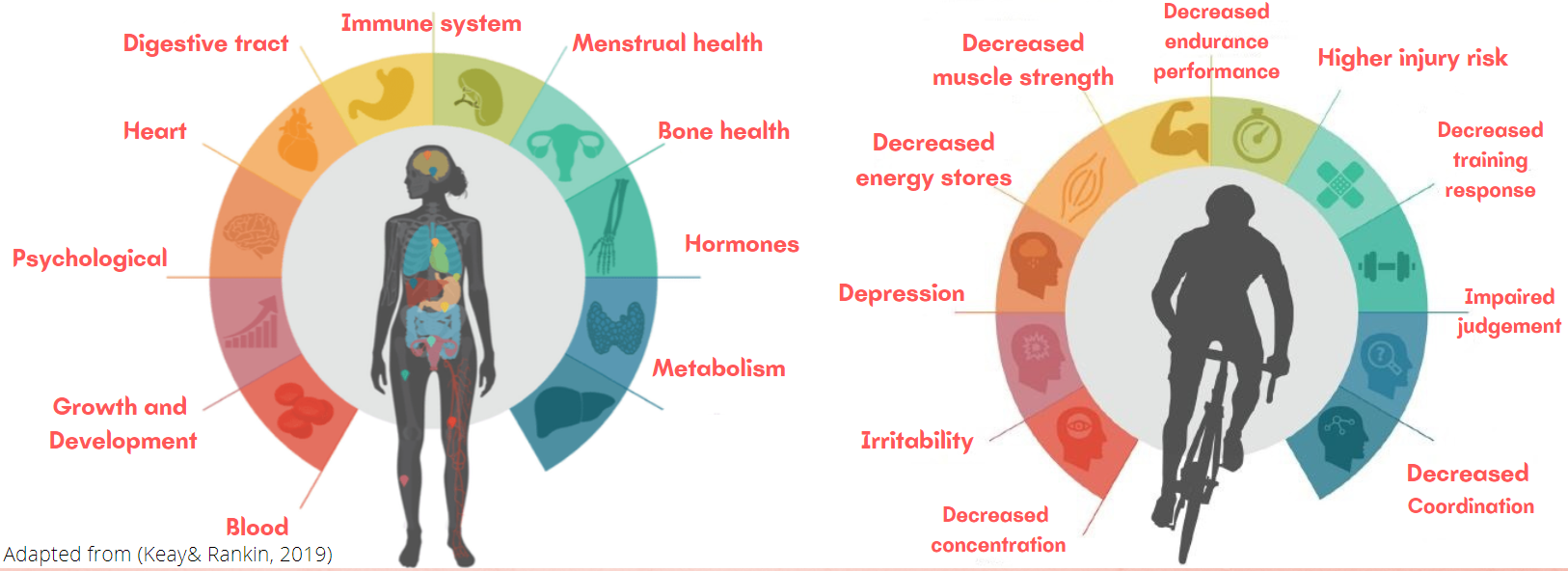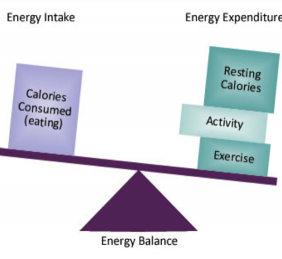Girls and female athletes are commonly concerned about eating too many calories but eating too few calories for their level of activity can result in a serious condition termed Relative Energy Deficiency in Sport (RED-S). Although this can also occur in men, it is more common in active women as well as sports where weight or a lean figure is emphasized, like gymnastics or Ballet for example.
Previously, there was an entity called the Female Athlete Triad. The triad included Menstrual dysfunction, disordered eating and Osteoporosis (weak bones). As our understanding of the condition expanded, it became clear that the underlying problem is the energy imbalance and the systems affected by this imbalance reached far beyond bone and menstrual health as described in the Female Athlete Triad.
RED-S now includes all the body's systems that can be negatively affected as depicted in the image below:

KEY QUESTIONS AND ANSWERS:

What is Relative Energy Deficiency?
Each of us have different energy requirements based on our gender, height, level of activity as well as other factors. Once your energy intake is not enough to meet the demands of your energy use, you have a state of relative energy deficiency or low energy availability. For all your body systems to work at their best, we want the Energy availability to match the Energy Expenditure. The diagram depicts the situation where the calories consumed is too few for the calories used.

Does this mean there is an eating disorder?
Not always, no. There can be various causes, only one of which is an eating disorder like Anorexia or Bulimia. Disordered eating is a better term as this includes a wider spectrum of conditions ultimately resulting in Low Energy Availability.
Are only elite athletes at risk?
No, all athletes at various levels of competition can be at risk. It is very easy for even recreational athletes to develop RED-S with all the societal pressures on leanness as well as all the fad-diets doing their rounds.
Why are menstrual cycles so important?
Many women would not mind the absence of their periods, but a normal menstrual cycle is a marker for good hormonal health. Oestrogen, one of the primary hormones involved in the menstrual cycle, is very important in the maintenance of your bone health.
Will starting an oral contraceptive pill (OCP) fix the problem?
No, OCP's often mask this abnormality. An oral contraceptive pill does not change the nutritional problem and merely masks it. OCP's do not cause a regular menstrual cycle, but merely results in regular withdrawal bleeds because ovulation is supressed.
How is RED-S diagnosed?
RED-S is a diagnosis of exclusion, which means that all other medical causes must be excluded first. It is important to educate all levels of athletes, parents, coaches, trainers as well as doctors to recognize some of the warning signs used to identify an energy deficiency. It may not be necessary in every case to do expensive tests, but looking at the athlete and listening to history can give us some very valuable clues, like:
- Menstrual irregularities: Ranging from long cycles to complete absence or disappearance of periods not due to pregnancy
- Low calorie intake or dietary restrictions
- Low Body Mass Index
- Recurrent injuries including stress fractures, shin splints or persistent hip pain
- Poor performance, very high training loads or a recent increase in training load
- Rapid weight loss
- Feeling cold on warm days
- Changed sleeping habits
- Increased fatigue
- Constipation and bloating
Why is treatment so important?
It is important to treat energy deficiency as it is not only detrimental to one's athletic performance, but also negatively affects your long-term health.
What does treatment entail?
Prevention by adequate awareness and early intervention is ideal. Depending on the symptoms, it is advised to consult a doctor, ideally someone experienced in the field like a sports medicine physician. Treatment involves a multi-disciplinary approach with the primary aim to restore the energy availability.
If you are concerned about your health and the possibility of RED-S, please contact Campus Health Service to make an appointment with a Sports Physician.
Stellenbosch Campus: 021 8083494/6 or Tygerberg Campus 021 938 9590

